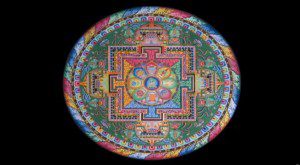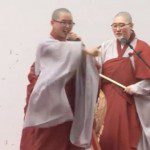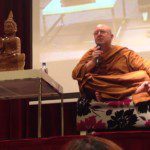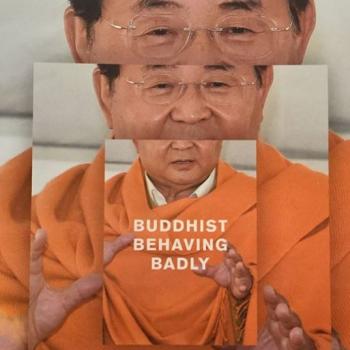I stumbled across this sutta the other day and appreciated the fact that the Buddha, 2500 years ago, was talking about sand castles (or ‘dirt houses’). The images of amazing creativity, wonder (perhaps infatuation), and impermanence of such structures couldn’t have been very different from what we see and think of today. This is especially true for those who know of the Tibetan Buddhist practice of creating, and then destroying, beautiful sand sculptures like the one above (see the video below for its full creation).
As Thanissaro below suggests, the mere act of analyzing the objects of our passion can be effective in our process of letting go of clinging to changing aspects of our life as if they were not changing. The Buddha tells his disciple that when one is caught up in desire, passion, and delight toward any of the five aggregates (or aspects of experience), then he/she is called ‘a being’. This is contrasted to the letting go of such passions and the result of ‘Unbinding’, a synonym for awakening. In contemporary language one might think of this as the contrast between the common demand that young people go out and “be somebody” in the world, which usually means creating, chasing, and acquiring a dream of some sort; and the counter cultural question: but why? What is this “being” created in the effort to “be somebody”?
Is it happy?
Does it make others happy?
Or does that “somebody” more often than not become yet another object for destruction, to be smashed, scattered and demolished?
Is there an alternative?
SN 23.2 PTS: S iii 189 CDB i 985
Satta Sutta: A Being
A number of discourses (among them, SN 35.191; AN 6.63) make the point that the mind is fettered, not by things like the five aggregates or the objects of the six senses, but by the act of passion & delight for them. There are two ways to try to cut through this fetter. One is to focus on the drawbacks of passion & delight in & of themselves, seeing clearly the stress & suffering they engender in the mind. The other is to analyze the objects of passion & delight in such a way that they no longer seem worthy of interest. This second approach is the one recommended in this discourse: when the Buddha talks of “smashing, scattering, & demolishing form (etc.) and making it unfit for play,” he is referring to the practice of analyzing form minutely into its component parts until it no longer seems a fit object for passion & delight. When all five aggregates can be treated in this way, the mind is left with no conditioned object to serve as a focal point for its passion, and so is released — at the very least — to the stage of Awakening called non-return.
I have heard that on one occasion the Blessed One was staying near Savatthi at Jeta’s Grove, Anathapindika’s monastery. Then Ven. Radha went to the Blessed One and, on arrival, having bowed down to him sat to one side. As he was sitting there he said to the Blessed One: “‘A being,’ lord. ‘A being,’ it’s said. To what extent is one said to be ‘a being’?”
“Any desire, passion, delight, or craving for form, Radha: when one is caught up[1] there, tied up[2] there, one is said to be ‘a being.’[3]
“Any desire, passion, delight, or craving for feeling… perception… fabrications…
“Any desire, passion, delight, or craving for consciousness, Radha: when one is caught up there, tied up there, one is said to be ‘a being.’
“Just as when boys or girls are playing with little sand castles:[4] as long as they are not free from passion, desire, love, thirst, fever, & craving for those little sand castles, that’s how long they have fun with those sand castles, enjoy them, treasure them, feel possessive of them. But when they become free from passion, desire, love, thirst, fever, & craving for those little sand castles, then they smash them, scatter them, demolish them with their hands or feet and make them unfit for play.
“In the same way, Radha, you too should smash, scatter, & demolish form, and make it unfit for play. Practice for the ending of craving for form.
“You should smash, scatter, & demolish feeling, and make it unfit for play. Practice for the ending of craving for feeling.
“You should smash, scatter, & demolish perception, and make it unfit for play. Practice for the ending of craving for perception.
“You should smash, scatter, & demolish fabrications, and make them unfit for play. Practice for the ending of craving for fabrications.
“You should smash, scatter, & demolish consciousness and make it unfit for play. Practice for the ending of craving for consciousness — for the ending of craving, Radha, is Unbinding.”
“Satta Sutta: A Being” (SN 23.2), translated from the Pali by Thanissaro Bhikkhu. Access to Insight (Legacy Edition), 30 November 2013,http://www.accesstoinsight.org/tipitaka/sn/sn23/sn23.002.than.html .













